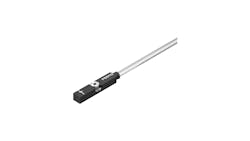Festo Introduces Programmable Proximity Switch with Automatic Switching Point Setting
Festo has introduced the SDBT-MSX programmable proximity switch which features automatic switching point setting. The switch offer a detection range of 20 mm. It is designed to be easy to install, particularly in applications where mounting is more difficult.
The company says the SDBT-MSX is suitable for various applications including factory automation and small parts handling.
A two-step installation process eases integration and commissioning of the SDBT-MSX into a customer's application. As Festo describes in its press release announcing the launch of the switch, users simply fit the switch in the approximate end stop position within the 20 mm detection range (which is marked on the sensor) and connects the cable to the controller (PLC). A power supply is not necessary, further easing installation.
More on the new SDBT-MSX from Festo's press release:
During first operation, the proximity switch detects the end position of the piston stroke and automatically learns and remembers the switching point. This is an industry first for a solid-state positioning switch.
Alternatively, the switching point of the SDBT-MSX can be taught manually using the capacitive control button. This button also allows the user to select PNP, NPN/ NO, or NC, and the switching window can be set from 2-15 mm. This flexibility can also reduce the variety of sensor types needed to be kept in inventory.
SDBT-MSX fits in all drives with a T-slot. It pairs best with drives from Festo, such as the DSBC ISO cylinder, DFM guided drive, DSNU round cylinder, ADN and ADN-S compact cylinders, and DGST mini-slide. Such pairings enable users to access the full capabilities of the switch.
About the Author
Sara Jensen
Executive Editor, Power & Motion
Sara Jensen is executive editor of Power & Motion, directing expanded coverage into the modern fluid power space, as well as mechatronic and smart technologies. She has over 15 years of publishing experience. Prior to Power & Motion she spent 11 years with a trade publication for engineers of heavy-duty equipment, the last 3 of which were as the editor and brand lead. Over the course of her time in the B2B industry, Sara has gained an extensive knowledge of various heavy-duty equipment industries — including construction, agriculture, mining and on-road trucks —along with the systems and market trends which impact them such as fluid power and electronic motion control technologies.
You can follow Sara and Power & Motion via the following social media handles:
X (formerly Twitter): @TechnlgyEditor and @PowerMotionTech
LinkedIn: @SaraJensen and @Power&Motion
Facebook: @PowerMotionTech

Leaders relevant to this article:

